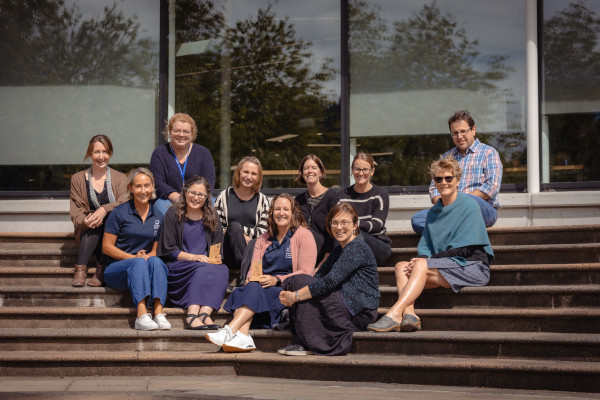- Tūhono home Hoki ki Tūhono
-
- Staff Directory
- Chief Executive Office Auckland International Office Corporate Services Finance Campus Services Functions and Catering Information Systems and Support Marketing, Communications and Engagement Learner Journey Academic Registry International Learner Services Te Punaka Ōwheo
- Learner Experience Academic Excellence Central Campus College of Community Development and Personal Wellbeing College of Engineering, Construction and Living Sciences College of Health College of Work Based Learning Open Education Resource/OERu Research and Postgraduate Studies Te Maru Pumanawa | College of Creative Practice and Enterprise
- Māori Development and Kaitohutohu Office People, Culture & Safety People and Culture Childcare Centre Te Ama Ako | Learning and Teaching Development Wellbeing and Safety Auckland Staff Directory Executive Office Academic Corporate Services Marketing and Business Development Human Resources Campus Quality and Programme Development
-
 Our people make a better world
Our people make a better world
We build the capabilities of individuals, organisations and communities and help them to realise their potential.
Staff Directory
-
- Tools
- Academic Integrity Declaration Form AIC Applications Dashboard Approved Programmes Approved Programme Fees Centralised Assessement Repository Chemwatch CMS - Tūhono & StudentHub updates Course Evaluation and Surveys CRM Applications CRM customer service hub Delegations policy/process Disability and Neurodiversity Dynamics 365 (CRM) EBS Ontrack EBS Report Email Security Personal Portal Employment Matters / Solarworkplace / Performance Reviews eTaxi eTV
- Financial Variance Reporting Hidden Disabilities Sunflower programme FCM travel intranet InPlace International entry requirements Knowledgebase articles Learner Capability Learner Support Dashboards Linkedin Learning Log a job with Marketing Login as an applicant Microsoft 365 Moderation App Moodle OP Docs OP Docs - Publishing OP Image Libraries Performance Excellence Portal Product Evaluation Panel
- Policy Library Privacy Programme and Course Design and Development Qualtrics XM RDS Remote Access Support Portal Research Database Robertson Library Staff FAQs about Graduation Status of Programmes Student Hub (Kāpehu demonstration view) Study Abroad info for learners Tūhauora I Wellbeing resources Uniprint Vault Webexpenses Auckland Tools
-
 Vault
Had an accident or near miss?
Log it here
Vault
Had an accident or near miss?
Log it here
-
- Communities
- Community AI Steering Committee Ally Network EBS Community of Interest EdTech Champions Health & Wellbeing Research Internal Evaluation Neurodiversity Professional Team Professoriate Proud@OP Student Support Website Advisory Group Web Champions Working under the Rainbow Project Learner Capability Trade Training Centre
- Committee Academic Committee Animals@OP Diversity and Equity Doctor of Professional Practice Committee Kaunihera Whakahaere - Leadership Council Internal Evaluation Learning & Teaching Leadership Team Library Committee Mental Health and Wellbeing Advisory Group Otago Polytechnic Board of Directors Pastoral Care Code Committee Programme Approvals Committee Research and Postgraduate Committee Research Ethics Committee Staff Subcommittee
- Think Tanks Mātauraka Our learners achieve educational success Pūtea Our financial success Tākata Our people, our team, our community Tiriti Our active commitment as a Treaty partner Tūroa Our commitment to be a sustainable and responsive organisation
-
 Create a community
Create a community
Do you have a community, committee or project that you'd like represented here?
Communities
-
- About OP
- Keep up to date All news All events All notices All blogs Share your info Create a news article Create an event Create a notice Create a blog
- Community and Partnerships Alumni and friends Education Foundation Operational information Academic calendar 2025 Academic calendar 2026 Current vacancies Dunedin campus map Our policies Topical FAQs
- Who we are Commemorative sites Māori Strategic Framework Our history Our strategic priorities Pasifika Strategic Framework (2025-2030) Vision and Values Working for us OP job opportunities Wellbeing Calendar Working at OP
-
New Zealand: 0800 762 786
contact us
International: +64 3 477 3014
Development of children's therapeutic pressure emitting apparel that addresses sensory integration dysfunction
Author: Tania Allan Ross
Development of children’s therapeutic pressure emitting apparel that addresses sensory integration dysfunction
Tania Allan-Ross
31 March 2015
Abstract
The long-term aim of this study is to design and manufacture customised contemporary garments for children with sensory integrative issues arising from the developmental disorder named sensory integration dysfunction (SID). These garments principally aim to aid the integration of tactile (touch) and proprioception (body position) for the wearer. It is foreseen in the near future that a therapeutic garment could be commercially produced that allows the wearer to modify sensation, specifically the experience of deep pressure in order to effect sought internal states of change of a physiological, cognitive or psychological nature. This section of the research study specially focuses on the trialling of the garment’s design with an emphasis on fabrication.
Context: This topic originated from my personal research into the lack of functional, appealing and discreet clothing for children that addresses the need for specific sensory feedback. This report records my research study to date beginning with a focus on understanding sensory integration dysfunction and existing treatments, in particular methods that provide deep pressure. The framework of a single case study for a client (a child who has sensory integration dysfunction) in conjunction with the use of a functional clothing design process, informs the initial development and testing of prototype garments. These were explored and enhanced through collaboration with the case study participant, their family and therapists. My personal interest in a client-centred approach to garment design stems from the experience of running a small made-to-measure apparel business in which a number of my clients had physical disabilities. My clients frequently offered possible garment engineering solutions to their individual clothing problems. I enjoyed this collaborative approach to designing and making. I now have a family member with an Autism Spectrum Disorder (ASD). Many of his sensory needs relate directly to clothing. Part of their early intervention therapy included the wearing of a weighted vest, which was unappealing on a visual and practical level. It had a very ‘homemade’ aesthetic, was ill-fitting and cumbersome for both the wearer and caregiver to handle. This experience motivated me to question the lack of functional, appealing and inclusive clothing for children needing sensory stimulation input from garments.
Tania Allan Ross' primary supervisor was Sian Griffiths.
License
This thesis is available under a Creative Commons Attribution-NonCommercial-NoDerivatives licence CC BY-NC-ND 4.0 International.
